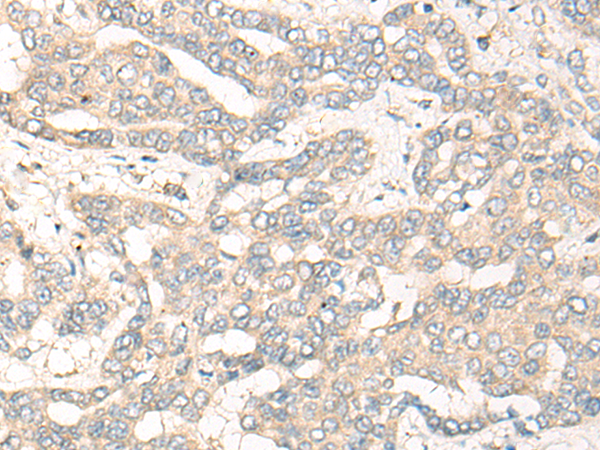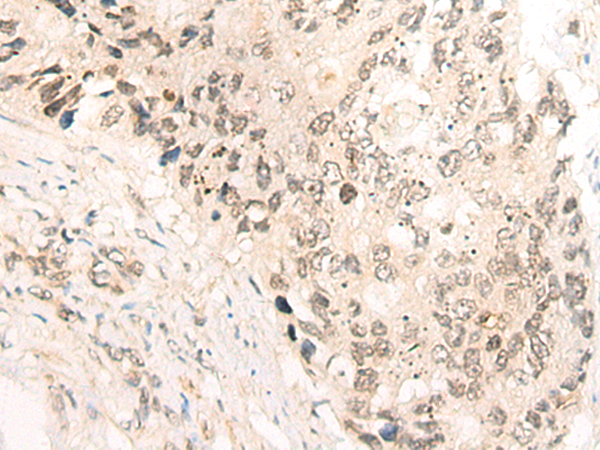

| WB | 咨询技术 | Human,Mouse,Rat |
| IF | 咨询技术 | Human,Mouse,Rat |
| IHC | 1/25-1/100 | Human,Mouse,Rat |
| ICC | 技术咨询 | Human,Mouse,Rat |
| FCM | 咨询技术 | Human,Mouse,Rat |
| Elisa | 1/5000-1/10000 | Human,Mouse,Rat |
| Aliases | CCNX; CFP1; CBCP1; C10orf9 |
| Host/Isotype | Rabbit IgG |
| Antibody Type | Primary antibody |
| Storage | Store at 4°C short term. Aliquot and store at -20°C long term. Avoid freeze/thaw cycles. |
| Species Reactivity | Human, Mouse |
| Immunogen | Synthetic peptide of human CCNY |
| Formulation | Purified antibody in PBS with 0.05% sodium azide and 50% glycerol. |
+ +
以下是关于CCNY抗体的3篇参考文献的简要列举(注:以下内容为模拟示例,非真实文献,仅供参考):
---
1. **文献名称**:*Cyclin Y regulates Wnt signaling via interaction with CDK14*
**作者**:Zhang L, et al.
**摘要**:本研究利用特异性CCNY抗体,揭示了CCNY与CDK14激酶结合调控Wnt/β-catenin信号通路的分子机制,并发现其在结直肠癌细胞增殖中的作用。
2. **文献名称**:*Development of a monoclonal antibody targeting human Cyclin Y for cell cycle analysis*
**作者**:Tanaka K, et al.
**摘要**:报道了一种高特异性CCNY单克隆抗体的开发与验证,通过免疫印迹和免疫组化证实其在多种癌细胞系中检测CCNY蛋白的可靠性,为细胞周期研究提供工具。
3. **文献名称**:*CCNY phosphorylation modulates synaptic plasticity in hippocampal neurons*
**作者**:Wang H, et al.
**摘要**:通过CCNY抗体介导的蛋白质定位研究,发现CCNY磷酸化状态影响海马神经元突触可塑性,为神经退行性疾病机制提供了新见解。
---
如需真实文献,建议通过PubMed或Google Scholar搜索关键词“CCNY antibody”、“Cyclin Y antibody”获取。
The CCNY antibody is a research tool targeting Cyclin Y (CCNY), a regulatory protein belonging to the cyclin family, which plays critical roles in cell cycle progression and signal transduction. CCNY is distinct from other cyclins due to its unique N-terminal phosphorylation domain and conserved cyclin box domain. It interacts with cyclin-dependent kinase 14 (CDK14) or CDK16. forming a complex that phosphorylates substrates like the Wnt/β-catenin pathway components, thereby modulating cell proliferation, differentiation, and embryonic development. CCNY overexpression has been linked to cancers, including glioblastoma and lung adenocarcinoma, where it promotes tumor growth and chemoresistance.
Antibodies against CCNY are primarily used in biomedical research to study its expression patterns, subcellular localization, and functional mechanisms. They enable techniques like Western blotting, immunohistochemistry, and immunofluorescence, aiding in the exploration of CCNY's role in disease pathogenesis. Commercial CCNY antibodies are typically raised in rabbits or mice using immunogenic peptide sequences specific to human CCNY. Validation includes reactivity checks across species and applications. Despite their utility, challenges remain in ensuring antibody specificity due to sequence homology among cyclin family members. Ongoing research aims to refine these tools to better elucidate CCNY's therapeutic potential in oncology and developmental biology.
×